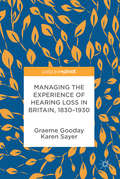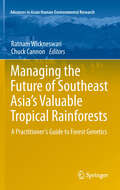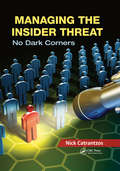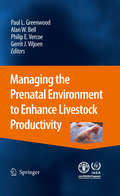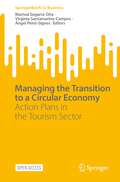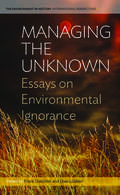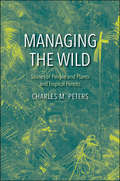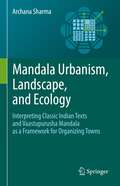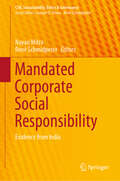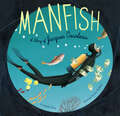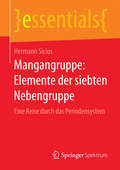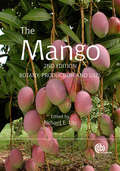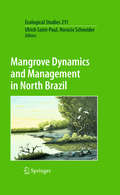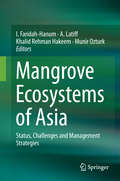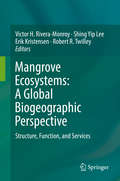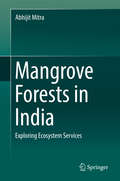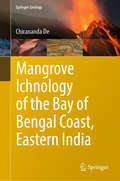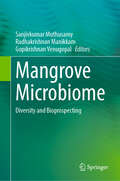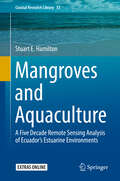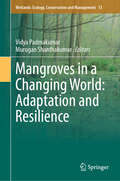- Table View
- List View
Managing the Environmental Crisis: Incorporating Competing Values in Natural Resource Administration
by William R. Mangun Daniel H. HenningSecond editionWith a new foreword by Lynton Keith CaldwellIn Managing the Environmental Crisis William R. Mangun and Daniel H. Henning provide a balanced and comprehensive guide to the management of complex environmental and natural resource policy issues. Taking into account new developments, trends, and issues that have arisen in recent years, the authors begin with the recognition, often overlooked, that it is not the environment that needs to be managed but human action relating to the environment. The authors review issues associated with a range of environmental policy concerns, including energy considerations, renewable and non renewable resource management, pollution control, wilderness management, and urban and regional policy. The history of these issues, recent actions pertaining to their management, difficulties associated with their continued presence, and the consequences of a failure to address these concerns are explored. Though focused on specific political issues, Mangun and Henning direct their attention to two large-scale trends--globalization and the political polarization of the environmental movement. At the level of the decision-making process, the incorporation of values--specifically addressed from multicultural and cross-disciplinary perspectives--is also discussed. International in scope, the book provides descriptions of the roles of both governmental and nongovernmental organizations in the formulations and implementation of national and global environmental policy. This thoroughly revised second edition discusses various successes in the arenas of environmental cooperation and management strategy while pointing to the new challenges that have emerged in the last decade.
Managing the Experience of Hearing Loss in Britain, 1830–1930
by Graeme Gooday Karen SayerThis book looks at how hearing loss among adults was experienced, viewed and treated in Britain before the National Health Service. We explore the changing status of ‘hard of hearing’ people during the nineteenth century as categorized among diverse and changing categories of ‘deafness’. Then we explore the advisory literature for managing hearing loss, and techniques for communicating with hearing aids, lip-reading and correspondence networks. From surveying the commercial selling and daily use of hearing aids, we see how adverse developments in eugenics prompted otologists to focus primarily on the prevention of deafness. The final chapter shows how hearing loss among First World War combatants prompted hearing specialists to take a more supportive approach, while it fell to the National Institute for the Deaf, formed in 1924, to defend hard of hearing people against unscrupulous hearing aid vendors. This book is suitable for both academic audiences and the general reading public. All royalties from sale of this book will be given to Action on Hearing Loss and the National Deaf Children’s Society.
Managing the Future of Southeast Asia's Valuable Tropical Rainforests
by Chuck Cannon Ratnam WickneswariThis book provides current knowledge about tropical rain forest genetics and its implications for the profitable and sustainable management of forest resources in Southeast Asia. Each chapter covers a major topic in the evolutionary biology of tropical rain forest trees and how management systems interact with these natural dynamics. Authors provide an up-to-date and insightful review of important scientific findings and conclude with practical recommendations for the modern forester in Southeast Asia. Several chapters provide compelling discussions about commonly neglected aspects of tropical forestry, including the impact of historical dynamics of climate change, anthropogenic threats to genetic viability, and the important role of wildlife in maintaining genetic diversity. These discussions will promote a deeper appreciation of not only the economic value of forests, but also their mystery and intangible values. The silvicultural industry in Southeast Asia is a major contributor to the regional economy but the connection between scientific research and the application and development of policy could be improved upon. This book will help bridge that gap. This book will prove beneficial reading for forestry students, professional forest managers, and policy makers, who do not have technical training in genetics. It is also intended for non-specialists who are involved in the tropical timber industry, from the local forest manager to the international timber purchasing agent.
Managing the Insider Threat: No Dark Corners
by Nick CatrantzosAn adversary who attacks an organization from within can prove fatal to the organization and is generally impervious to conventional defenses. Drawn from the findings of an award-winning thesis, Managing the Insider Threat: No Dark Corners is the first comprehensive resource to use social science research to explain why traditional methods fail aga
Managing the Mountains
by Sara M. GreggHistorians have long viewed the massive reshaping of the American landscape during the New Deal era as unprecedented. This book uncovers the early twentieth-century history rich with precedents for the New Deal in forest, park, and agricultural policy. Sara M. Gregg explores the redevelopment of the Appalachian Mountains from the 1910s through the 1930s, finding in this region a changing paradigm of land use planning that laid the groundwork for the national New Deal. Through an intensive analysis of federal planning in Virginia and Vermont, Gregg contextualizes the expansion of the federal government through land use planning and highlights the deep intellectual roots of federal conservation policy.
Managing the Prenatal Environment to Enhance Livestock Productivity
by Alan W. Bell Paul L. Greenwood Gerrit J. Viljoen Philip E. VercoePrenatal life is the period of maximal development in animals, and it is well recognised that factors that alter development can have profound effects on the embryonic, fetal and postnatal animal. Scientists involved in research on livestock productivity have for decades studied postnatal consequences of fetal development on productivity. Recently, however, there has been a surge in interest in how to manage prenatal development to enhance livestock health and productivity. This has occurred largely due to the studies that show human health in later life can be influenced by events during prenatal life, and establishment of the Fetal Origins and the Thrifty Phenotype Hypotheses. This book, Managing the Prenatal Environment to Enhance Livestock Productivity reviews phenotypic consequences of prenatal development, and provides details of mechanisms that underpin these effects in ruminants, pigs and poultry. The chapters have been divided into three parts: Quantification of prenatal effects on postnatal productivity, mechanistic bases of postnatal consequences of prenatal development and regulators of fetal and neonatal nutrient supply. Managing the Prenatal Environment to Enhance Livestock Productivity is a reference from which future research to improve the level of understanding and capacity to enhance productivity, health and efficiency of livestock in developing and developed countries will evolve. It is particularly timely given the development of molecular technologies that are providing new insight into regulation and consequences of growth and development of the embryo, fetus and neonate.
Managing the Transition to a Circular Economy: Action Plans in the Tourism Sector (SpringerBriefs in Business)
by Virginia Santamarina-Campos Marival Segarra-Oña Ángel Peiró-SignesThis open access book presents an interdisciplinary analysis of the current status of the circular economy in the tourism sector. This book is presented from the perspective of researchers, policymakers, and industry. Specially aimed at companies in the tourism sector, the book offers valuable information in the field of circular economy, promoting the design/redesign of processes and products. The authors emphasize promoting the development and application of new knowledge and technologies to promote innovation in processes, products, services, and business models, promoting public-private collaboration. With contributions from experts representing varied interests throughout the tourism industry, the book encourages the involvement of economic and social agents to raise awareness of current environmental, economic, and technological challenges.
Managing the Unknown: Essays on Environmental Ignorance
by Frank Uekötter Uwe LübkenInformation is crucial when it comes to the management of resources. But what if knowledge is incomplete, or biased, or otherwise deficient? How did people define patterns of proper use in the absence of cognitive certainty? Discussing this challenge for a diverse set of resources from fish to rubber, these essays show that deficient knowledge is a far more pervasive challenge in resource history than conventional readings suggest. Furthermore, environmental ignorance does not inevitably shrink with the march of scientific progress: these essays suggest more of a dialectical relationship between knowledge and ignorance that has different shapes and trajectories. With its combination of empirical case studies and theoretical reflection, the essays make a significant contribution to the interdisciplinary debate on the production and resilience of ignorance. At the same time, this volume combines insights from different continents as well as the seas in between and thus sketches outlines of an emerging global resource history.
Managing the Wild: Stories of People and Plants and Tropical Forests
by Charles M. PetersDrawn from ecologist Charles M. Peters’s thirty†‘five years of fieldwork around the globe, these absorbing stories argue that the best solutions for sustainably managing tropical forests come from the people who live in them. As Peters says, “Local people know a lot about managing tropical forests, and they are much better at it than we are.” With the aim of showing policy makers, conservation advocates, and others the potential benefits of giving communities a more prominent conservation role, Peters offers readers fascinating backstories of positive forest interactions. He provides examples such as the Kenyah Dayak people of Indonesia, who manage subsistence orchards and are perhaps the world’s most gifted foresters, and communities in Mexico that sustainably harvest agave for mescal and demonstrate a near†‘heroic commitment to good practices. No forest is pristine, and Peters’s work shows that communities have been doing skillful, subtle forest management throughout the tropics for several hundred years.
Mandala Urbanism, Landscape, and Ecology: Interpreting classic Indian texts and Vaastupurusha mandala as a framework for organizing towns
by Archana SharmaClassic Indian texts and Vaastupurusha Mandala are not often discussed in the western discourse on urbanism, even while much of these predate the commonly taught European writings. This book sheds light on some of those forgotten concepts, thus making the lesser discussed classic Indian town organization ideas accessible to architecture, landscape, and urban planning students worldwide. The resonance of these concepts in present times are reviewed through case studies of select Hindu temple towns in India. Furthermore, the author underscores the formal abstraction of the classic Indian Mandala and transplants the discourse from sociology to socio-ecologically adept trans-disciplinary design thinking. The creative interpretations offer a premise to start revising classic models for current practice to influence the urbanism and ecology of a place in accordance with the changing climate.
Mandated Corporate Social Responsibility: Evidence from India (CSR, Sustainability, Ethics & Governance)
by René Schmidpeter Nayan MitraThis book examines the Indian mandate for Corporate Social Responsibility (CSR) and its implementations in various individual organizations. Although the mandate is applicable only to certain large and stable companies, many believe that India is poised to become the birthplace of social, economic and environmental transformation, given the immense size of the Indian population and its challenging socio-economic index. The book explores the various facets of CSR investigation and places special emphasis on the Schedule VII of the Indian Companies Act of 2013, which defines specific areas of intervention for these companies. In addition, it provides a wealth of first-hand case studies that exemplify the ongoing developments and the fundamental challenges and opportunities of mandated CSR.
Manfish: A Story of Jacques Cousteau
by Jennifer Berne Eric PuybaretBefore Jacques Cousteau became an internationally known oceanographer and champion of the seas, he was a curious little boy. In this lovely biography, poetic text and gorgeous paintings combine to create a portrait of Jacques Cousteau that is as magical as it is inspiring. <p><p> <i>Advisory: Bookshare has learned that this book offers only partial accessibility. We have kept it in the collection because it is useful for some of our members. Benetech is actively working on projects to improve accessibility issues such as these in the future.</i>
Mangangruppe: Eine Reise durch das Periodensystem (essentials)
by Hermann SiciusHermann Sicius stellt ausf#65533;hrlich die Elemente der siebten Nebengruppe (Mangangruppe) vor. Er zeigt, dass die Elemente dieser Gruppe, mit Ausnahme des Mangans, chemisch meist relativ reaktionstr#65533;ge sind und regelm#65533;#65533;ige Abstufungen ihrer Eigenschaften zeigen. So nehmen vom Mangan zum Rhenium Dichte, Schmelz- und Siedepunkte zu, die Reaktivit#65533;t jedoch ab. Mangan findet sich als Bestandteil sehr harter St#65533;hle, Technetium wird als Radiotherapeutikum eingesetzt, Braunstein wird in Batterien ben#65533;tigt, Kaliumpermanganat als Desinfektionsmittel und Rhenium als Bestandteil erm#65533;dungsfreier Legierungen f#65533;r Turbinenschaufeln eingesetzt. Technetium war das erste Element, das nur auf k#65533;nstlichem Wege erstmals dargestellt werden konnte, Rhenium ist eines der seltensten Elemente in der Erdh#65533;lle und nur Mangan kommt mit einem Anteil von 850 ppm noch relativ verbreitet vor. Bohrium wiederum, das schwerste Element der Gruppe, ist ebenfalls nur durch k#65533;nstliche Prozesse (Kernfusion) zug#65533;nglich. p>
Mangangruppe: Eine Reise durch das Periodensystem (essentials)
by Hermann SiciusHermann Sicius stellt ausführlich die Elemente der siebten Nebengruppe (Mangangruppe) vor. Er zeigt, dass die Elemente dieser Gruppe, mit Ausnahme des Mangans, chemisch meist relativ reaktionsträge sind und regelmäßige Abstufungen ihrer Eigenschaften zeigen. So nehmen vom Mangan zum Rhenium Dichte, Schmelz- und Siedepunkte zu, die Reaktivität jedoch ab. Mangan findet sich als Bestandteil sehr harter Stähle, Technetium wird als Radiotherapeutikum eingesetzt, Braunstein wird in Batterien benötigt, Kaliumpermanganat als Desinfektionsmittel und Rhenium als Bestandteil ermüdungsfreier Legierungen für Turbinenschaufeln eingesetzt. Technetium war das erste Element, das nur auf künstlichem Wege erstmals dargestellt werden konnte, Rhenium ist eines der seltensten Elemente in der Erdhülle und nur Mangan kommt mit einem Anteil von 850 ppm noch relativ verbreitet vor. Bohrium wiederum, das schwerste Element der Gruppe, ist ebenfalls nur durch künstliche Prozesse (Kernfusion) zugänglich.
Mango
by Richard LitzThe Mango is one of the oldest cultivated fruit crops, having been grown in India for at least 4000 years. Mango is the most important fruit crop of Asia and its annual production is exceeded worldwide only by Musa, citrus, grapes and apples. The last decade has seen a rapid growth of mango production, mainly due to expansion into new growing regions but also to the adoption of modern field practices and cultivars. A wide range of fresh, mango cultivars are now consumed worldwide and are available year round. The Mango: Botany, Production and Uses, published in 1997, represented the first comprehensive examination of all aspects of modern mango production and research. Developing upon the successful first edition, this book incorporates a discussion of significant advances in mango research that have contributed to improved production and will be highly relevant for researchers and growers alike.
Mango Malformation
by D. K. ChakrabartiMalformation disease of mango (Mangifera indica) initially noted in patches in India has now turned into a global menace wherever mango is grown. The challenge posed by the problem attracted interest of Scientists from various disciplines, continue to do so, and will attract their attention until the problem is understood threadbare, and resolved. For a long time, due to complex nature of the disease, the cause and causal agent was both hotly debated. Only in recent years, the issue of the etiology of the disease has been resolved, epidemiology has been worked out to a large extent and silver bullet control measures have been replaced by IPM strategy based on the information generated on the physiology of pathogenesis and epidemiology of the disease.
Mangrove Carbon Trading in the Lower Gangetic Delta: Drawbacks and the Potential
by Abhijit Mitra Sufia Zaman Prosenjit Pramanick Sana AhmedTrue mangrove flora and their associates in the lower Gangetic region are noted for their wide spectrum of ecosystem services in which carbon storage and sequestration by the forest is one of the most important components. Many researchers are updating the carbon repository of the lower Gangetic delta mangroves with the aim to ascertain their role to reduce the carbon dioxide level of the near surface atmosphere. However, due to difficulty in assessment, marketing, and lack of clarity over ownership of natural resources, the mangrove-based carbon trading system has not yet crystallized.There is an estimated 13.76 Mha of mangrove forests world-wide, approximately 20% (2.6 Mha) of which is potentially investible for carbon finance projects, based on the probability of imminent threat. The magnitude and the variability of threats to which the mangroves of the lower Gangetic delta are exposed to have made the trading process more complicated. In addition, gaps also exist between the national government policy and the trading of the blue carbon projects, which has kept the future of such projects remain on hold. The authors put forward the views that the creation of more financial facilities for restoration and expansion of blue carbon (preferably mangroves) with the involvement of the local communities can provide the initial capital involved in developing mangrove-based carbon projects. This includes the costs of conducting feasibility studies, implementing capacity-building programs, monitoring the health of the mangrove plantation/restoration on regular basis, and creating mangrove-based alternative livelihood programs that will support island dwellers of the region in order to accelerate the magnitude of mangrove-based carbon projects leading to growth of the mangrove trading market.
Mangrove Dynamics and Management in North Brazil
by Horacio Schneider Ulrich Saint-PaulMangrove ecosystems are being increasingly threatened by human activities. Their biotic productivity supplies food and other resources to the human populations that inhabit or make use of them. This volume highlights the results of a ten-year German / Brazilian research project, called MADAM, in one of the largest continuous mangrove areas of the world, located in northern Brazil. Based on the analysis of the ecosystem dynamics, management strategies for the conservation and sustainable use of mangroves are presented and discussed. Beyond the scientific results, this book also provides guidelines for the development of international cooperation projects.
Mangrove Ecosystems of Asia
by Khalid Rehman Hakeem Munir Ozturk I. Faridah-Hanum A. LatiffThe book provides an up-to-date account of mangrove forests from Asia, together with restoration techniques, and the management requirements of these ecosystems to ensure their sustainability and conservation. All aspects of mangroves and their conservation are critically re-examined. The book is divided into three sections presenting the distribution and status of mangrove ecosystems in Asia, the challenges they are facing, their issues and opportunities, and the management strategies for their conservation.
Mangrove Ecosystems: A Global Biogeographic Perspective
by Victor H. Rivera-Monroy Shing Yip Lee Erik Kristensen Robert R. TwilleyThis book presents a comprehensive overview and analysis of mangrove ecological processes, structure, and function at the local, biogeographic, and global scales and how these properties interact to provide key ecosystem services to society. The analysis is based on an international collaborative effort that focuses on regions and countries holding the largest mangrove resources and encompasses the major biogeographic and socio-economic settings of mangrove distribution. Given the economic and ecological importance of mangrove wetlands at the global scale, the chapters aim to integrate ecological and socio-economic perspectives on mangrove function and management using a system-level hierarchical analysis framework. The book explores the nexus between mangrove ecology and the capacity for ecosystem services, with an emphasis on thresholds, multiple stressors, and local conditions that determine this capacity. The interdisciplinary approach and illustrative study cases included in the book will provide valuable resources in data, information, and knowledge about the current status of one of the most productive coastal ecosystem in the world.
Mangrove Forests in India: Exploring Ecosystem Services
by Abhijit MitraThis is the first comprehensive science-based primer to highlight the unique ecosystem services provided by mangrove forests, and discuss how these services preserve the livelihoods of coastal populations. The book presents three decades of real-time data on Sundarbans and Bhitarkanika mangroves in India measuring carbon and nitrogen sequestration, as well as case studies that demonstrate the utility provided by mangroves for reducing the impact of storms and erosion, providing nutrient retention for complex habitats, and housing a vast reservoir of plant, animal and microbial biodiversity. Also addressed is the function of mangroves as natural ecosystems of cultural convergence, offering the resources and products necessary for thriving coastal communities. The book will be of interest to students, academics and researchers in the fields of oceanography, marine biology, botany, climate science, ecology and environmental geography, as well as consultants and policy makers working in coastal zone management and coastal biodiversity conservation.
Mangrove Ichnology of the Bay of Bengal Coast, Eastern India (Springer Geology)
by Chirananda DeThis book focuses on the world’s largest mangrove delta complex, located at Sundarban, a world heritage site, and on the relatively new and rapidly expanding scientific discipline of ichnology. In addition to presenting a range of ichnological research databases that are widely applicable to multidisciplinary research fields in geology, biophysics, biology, ecology, geomorphology and the marine and environmental sciences, it addresses the global concern of rising sea levels to explain growing ecological problems, from the mass mortality of coastal organisms and rapid loss of mangrove forest wealth, to widespread coastal and riverbank erosion. It also demonstrates the value of applying new ichnological tools to coastal geotechnical planning and programming, and to groundwater exploration. Thus, the book addresses a broad readership including earth scientists from various disciplines, state administrators and members of the general public.
Mangrove Microbiome: Diversity and Bioprospecting
by Radhakrishnan Manikkam Sanjivkumar Muthusamy Gopikrishnan VenugopalThis book highlights the diversity, and industrial and bio-therapeutic applications of mangrove associated microbiomes. The bioactive metabolites from the mangrove microbiomes show high antimicrobial, antioxidant, anti-inflammatory, anticancer, antidiabetic and anti-biofilm activities. Their environmentally significant capabilities such as remediation, degradation and agriculture enhancing properties are discussed in this book as well. Mangroves are extremely nutrient-rich and productive ecosystems found adjacent to coastal waters and they stand at the base of an extensive food web. Diverse groups of metabolically active microbial populations of this ecosystem produce economically important bio-active metabolites which have environmental, cosmetic, food and biomedical industrial applications. This book aims to consolidate the research, bridge the knowledge gaps, and stimulate further research on mangrove microbiomes. It provides a valuable resource that benefits the scientific community, academic researchers, healthcare practitioners, and individuals interested in the potential use of microbial populations of mangrove ecosystem in managing bio-efficiencies.
Mangroves and Aquaculture: A Five Decade Remote Sensing Analysis of Ecuador’s Estuarine Environments (Coastal Research Library #33)
by Stuart E. HamiltonThis book uses five decades of map data, air photos, and medium to high-resolution satellite imagery to track the expansions of aquaculture and the loss of both estuarine and mangrove land covers in Ecuador. The results are staggering. In some regions, Ecuador has lost almost 50% of its estuarine space and approximately 80% of its mangrove forest. The current estuarine land cover bears no resemblance to the historic estuarine land cover. The analysis is complete from 1968 to 2014. The analysis covers all the major estuaries of mainland Ecuador. The research expands beyond purely land cover into the land use of the estuaries and the implications of the land cover transitions. The author lived in Ecuador's estuarine environments for almost two years studying this area. During this time he conducted mapping workshops with local residents, conducted 100 interviews with local actors, conducted six group discussions with fisherfolk syndicates, conducted eight presentations, worked on a shrimp farm. He was employed by the Ministry of the Environment on a Prometeo fellowship for one-year researching estuarine health and worked on mangrove replanting projects in the estuaries. In addition to the remote sensing data, the author provides a contextual framework to the analysis. It is not just hard numbers that are presented, but a remote sensing analysis tied to local actors that tell a coherent almost 50 -year estuarine story at the national, provincial, and local scales The book is intended for researchers, academics, graduate students, NGOs, and government actors including those who work in development, environment, and policy implementation. It is suitable supplemental reading for students in courses related to the coastal zone, land use change, and remote sensing. The electronically supplementary material includes all the related data to underpin the analysis as well as all the resulting GIS files.
Mangroves in a Changing World: Adaptation and Resilience (Wetlands: Ecology, Conservation and Management #13)
by Vidya Padmakumar Murugan ShanthakumarMangroves are among the most productive and diverse ecosystems on Earth, providing a range of ecosystem services that benefit millions of people and support global sustainability goals. However, mangroves are also highly vulnerable to climate change impacts, such as sea level rise, storms, salinity changes, and erosion, which threaten their survival and functionality. This book aims to provide researchers with the latest scientific knowledge and practical tools to understand, assess, and enhance the adaptation and resilience of mangroves to climate change. It covers topics such as mangrove ecology and distribution, mangrove ecosystem services and valuation, mangrove adaptation and resilience mechanisms and indicators, mangrove restoration and conservation strategies, mangrove governance and policy frameworks, and mangrove modelling and mapping approaches. The book also showcases case studies from different regions of the world, highlighting the challenges and opportunities of mangrove management in a changing world. The book is intended to serve as a valuable reference and resource for researchers, students, practitioners, policymakers, and anyone interested in mangrove science and management.

